AAF043-6 Financial Planning: Strategic Managerial Accounting
VerifiedAdded on 2023/06/17
|12
|3660
|99
Report
AI Summary
This report provides a comprehensive analysis of financial planning within management accounting, addressing key topics such as the effectiveness of direct expenses in dynamic marketing, the utility and constraints of financial management approaches like Payback Period, NPV, ARR, and IRR when evaluating investment opportunities, the significance of planning as a tactical managerial accounting instrument, and the methods used by tax officials to assess transaction costs. The report critically examines the advantages and disadvantages of each investment appraisal method, emphasizing the importance of considering both short-term and long-term implications in financial decision-making. Furthermore, it explores the role of planning in assisting firms post-COVID-19 and the considerations involved in determining the fairness of transaction costs from a taxation perspective. This document is available on Desklib, a platform offering a wide range of study resources including past papers and solved assignments for students.
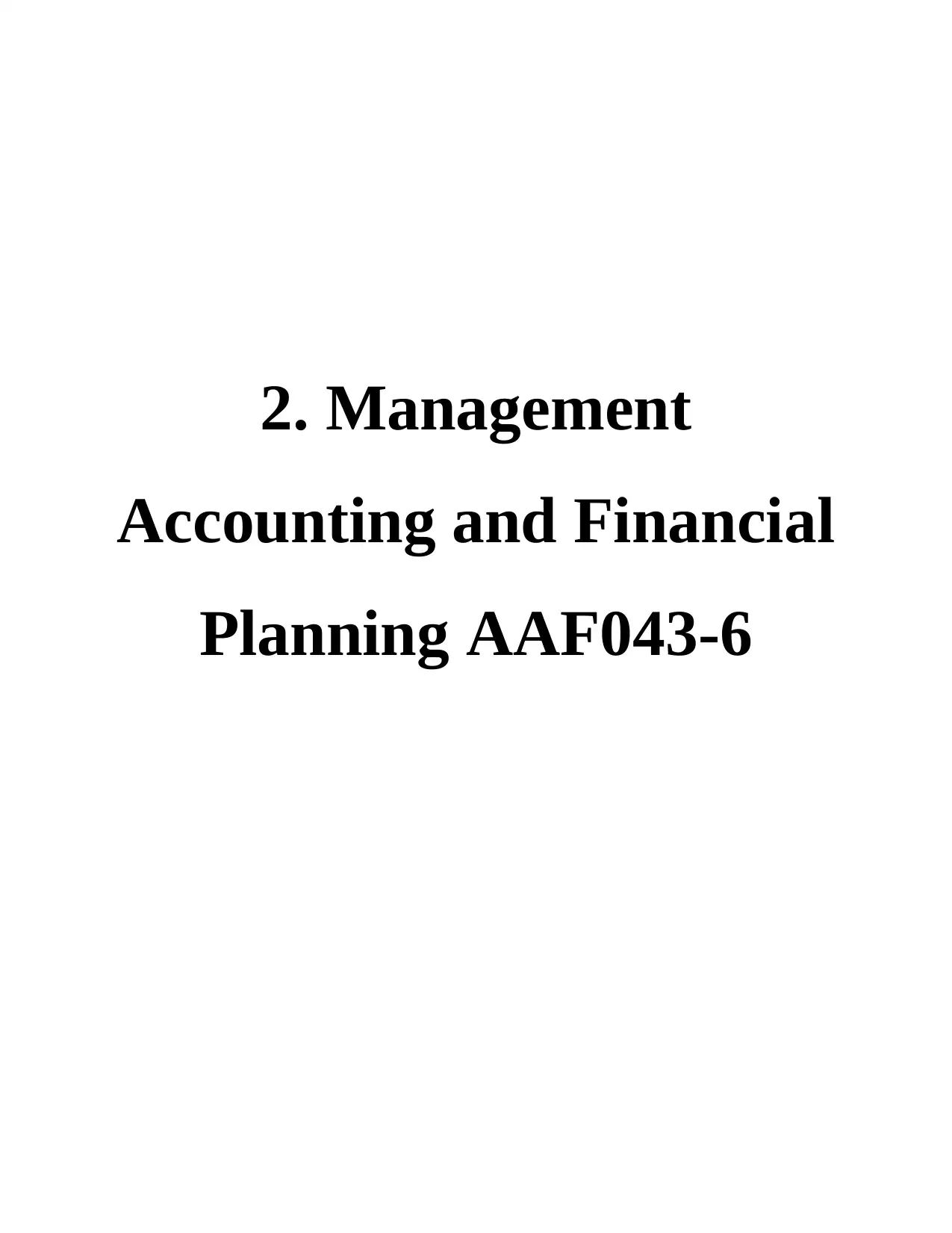
2. Management
Accounting and Financial
Planning AAF043-6
Accounting and Financial
Planning AAF043-6
Paraphrase This Document
Need a fresh take? Get an instant paraphrase of this document with our AI Paraphraser
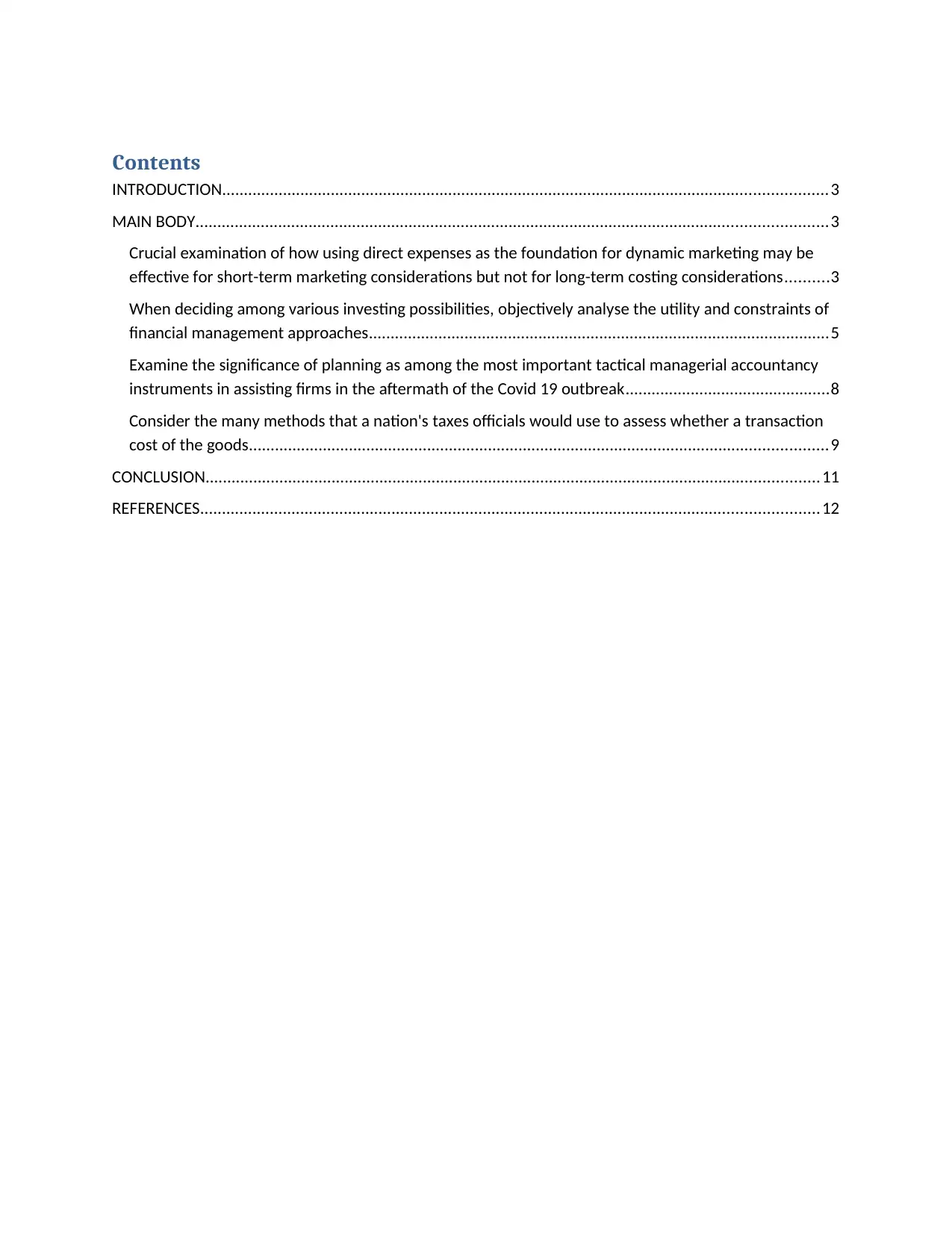
Contents
INTRODUCTION...........................................................................................................................................3
MAIN BODY.................................................................................................................................................3
Crucial examination of how using direct expenses as the foundation for dynamic marketing may be
effective for short-term marketing considerations but not for long-term costing considerations..........3
When deciding among various investing possibilities, objectively analyse the utility and constraints of
financial management approaches..........................................................................................................5
Examine the significance of planning as among the most important tactical managerial accountancy
instruments in assisting firms in the aftermath of the Covid 19 outbreak...............................................8
Consider the many methods that a nation's taxes officials would use to assess whether a transaction
cost of the goods.....................................................................................................................................9
CONCLUSION.............................................................................................................................................11
REFERENCES..............................................................................................................................................12
INTRODUCTION...........................................................................................................................................3
MAIN BODY.................................................................................................................................................3
Crucial examination of how using direct expenses as the foundation for dynamic marketing may be
effective for short-term marketing considerations but not for long-term costing considerations..........3
When deciding among various investing possibilities, objectively analyse the utility and constraints of
financial management approaches..........................................................................................................5
Examine the significance of planning as among the most important tactical managerial accountancy
instruments in assisting firms in the aftermath of the Covid 19 outbreak...............................................8
Consider the many methods that a nation's taxes officials would use to assess whether a transaction
cost of the goods.....................................................................................................................................9
CONCLUSION.............................................................................................................................................11
REFERENCES..............................................................................................................................................12
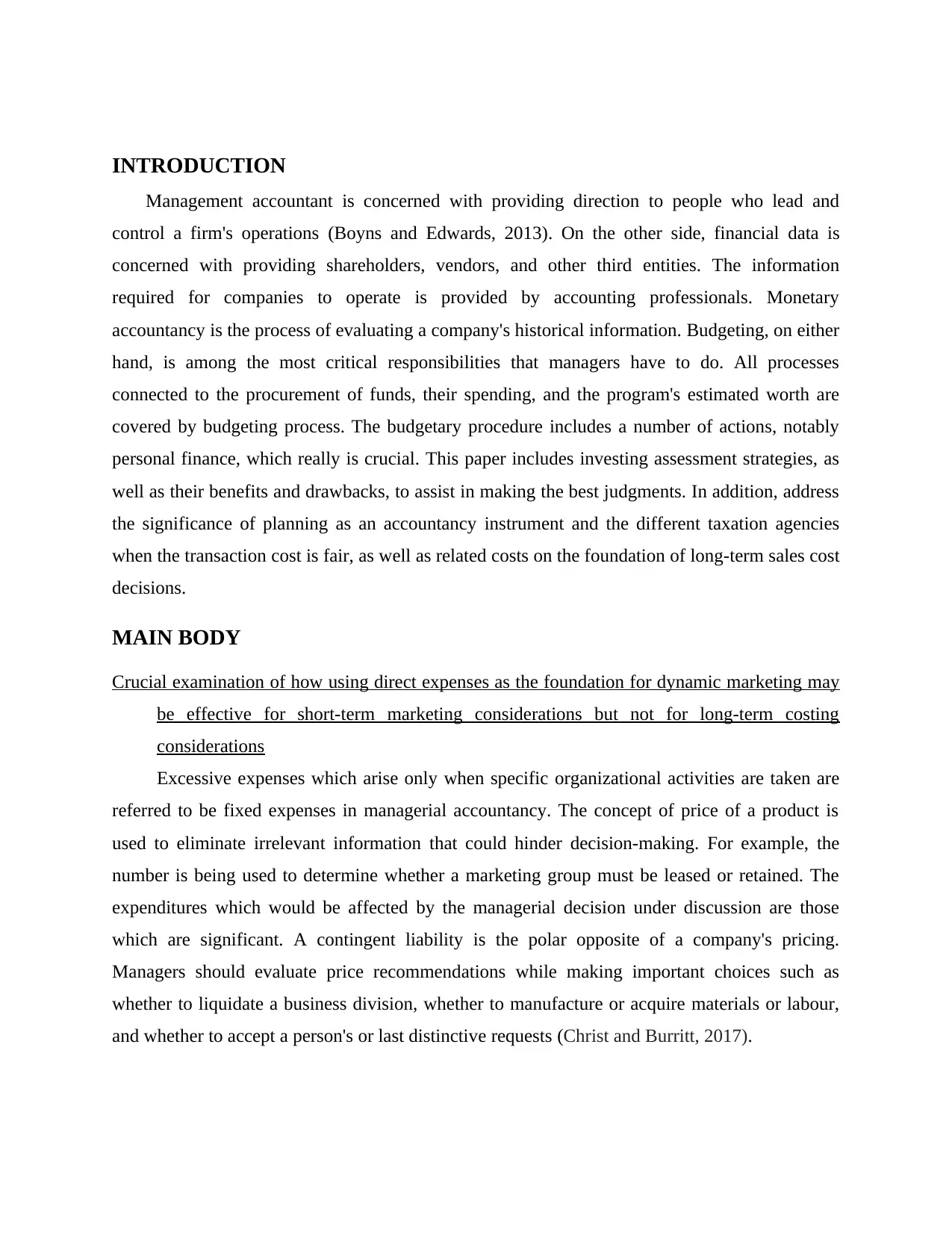
INTRODUCTION
Management accountant is concerned with providing direction to people who lead and
control a firm's operations (Boyns and Edwards, 2013). On the other side, financial data is
concerned with providing shareholders, vendors, and other third entities. The information
required for companies to operate is provided by accounting professionals. Monetary
accountancy is the process of evaluating a company's historical information. Budgeting, on either
hand, is among the most critical responsibilities that managers have to do. All processes
connected to the procurement of funds, their spending, and the program's estimated worth are
covered by budgeting process. The budgetary procedure includes a number of actions, notably
personal finance, which really is crucial. This paper includes investing assessment strategies, as
well as their benefits and drawbacks, to assist in making the best judgments. In addition, address
the significance of planning as an accountancy instrument and the different taxation agencies
when the transaction cost is fair, as well as related costs on the foundation of long-term sales cost
decisions.
MAIN BODY
Crucial examination of how using direct expenses as the foundation for dynamic marketing may
be effective for short-term marketing considerations but not for long-term costing
considerations
Excessive expenses which arise only when specific organizational activities are taken are
referred to be fixed expenses in managerial accountancy. The concept of price of a product is
used to eliminate irrelevant information that could hinder decision-making. For example, the
number is being used to determine whether a marketing group must be leased or retained. The
expenditures which would be affected by the managerial decision under discussion are those
which are significant. A contingent liability is the polar opposite of a company's pricing.
Managers should evaluate price recommendations while making important choices such as
whether to liquidate a business division, whether to manufacture or acquire materials or labour,
and whether to accept a person's or last distinctive requests (Christ and Burritt, 2017).
Management accountant is concerned with providing direction to people who lead and
control a firm's operations (Boyns and Edwards, 2013). On the other side, financial data is
concerned with providing shareholders, vendors, and other third entities. The information
required for companies to operate is provided by accounting professionals. Monetary
accountancy is the process of evaluating a company's historical information. Budgeting, on either
hand, is among the most critical responsibilities that managers have to do. All processes
connected to the procurement of funds, their spending, and the program's estimated worth are
covered by budgeting process. The budgetary procedure includes a number of actions, notably
personal finance, which really is crucial. This paper includes investing assessment strategies, as
well as their benefits and drawbacks, to assist in making the best judgments. In addition, address
the significance of planning as an accountancy instrument and the different taxation agencies
when the transaction cost is fair, as well as related costs on the foundation of long-term sales cost
decisions.
MAIN BODY
Crucial examination of how using direct expenses as the foundation for dynamic marketing may
be effective for short-term marketing considerations but not for long-term costing
considerations
Excessive expenses which arise only when specific organizational activities are taken are
referred to be fixed expenses in managerial accountancy. The concept of price of a product is
used to eliminate irrelevant information that could hinder decision-making. For example, the
number is being used to determine whether a marketing group must be leased or retained. The
expenditures which would be affected by the managerial decision under discussion are those
which are significant. A contingent liability is the polar opposite of a company's pricing.
Managers should evaluate price recommendations while making important choices such as
whether to liquidate a business division, whether to manufacture or acquire materials or labour,
and whether to accept a person's or last distinctive requests (Christ and Burritt, 2017).
⊘ This is a preview!⊘
Do you want full access?
Subscribe today to unlock all pages.

Trusted by 1+ million students worldwide
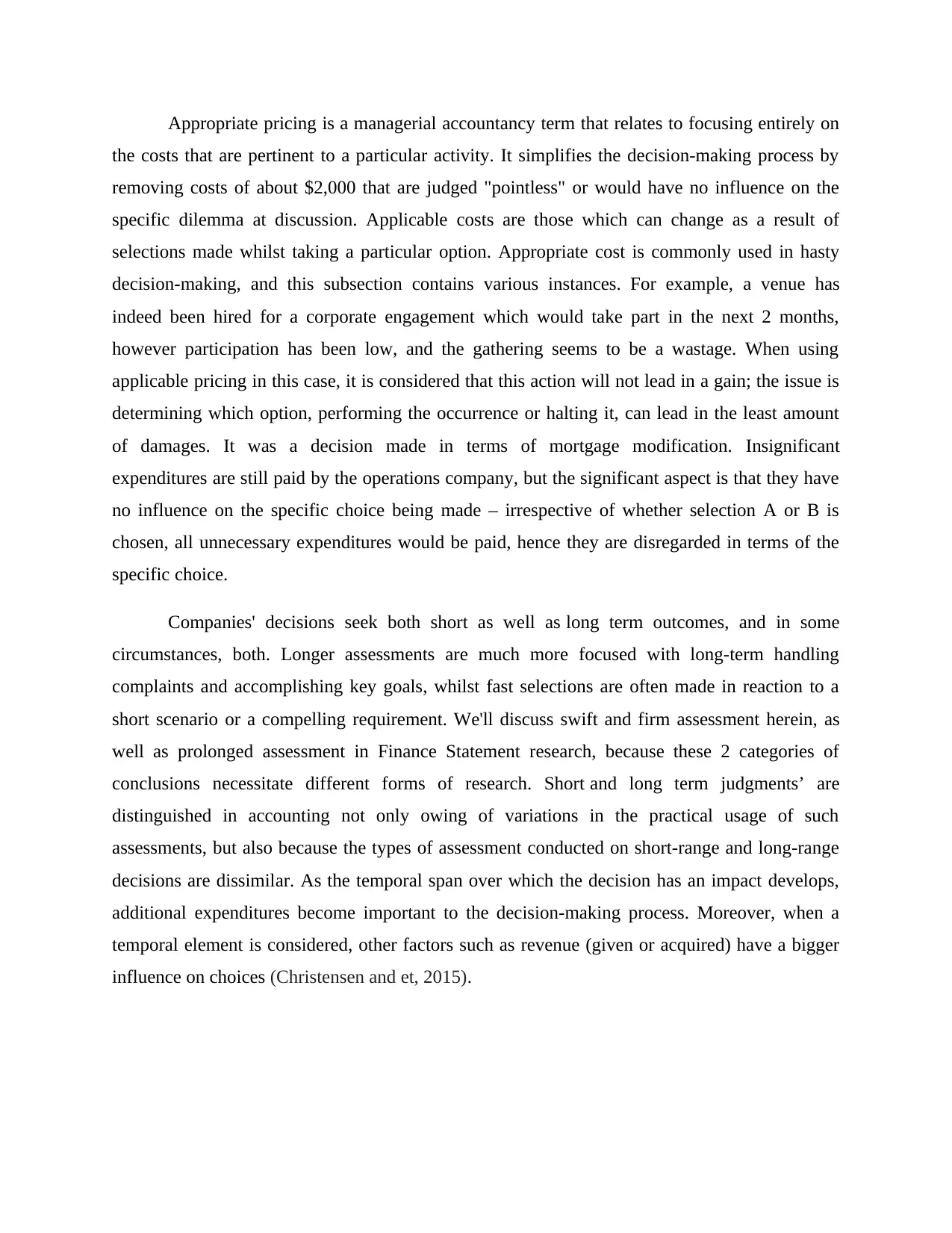
Appropriate pricing is a managerial accountancy term that relates to focusing entirely on
the costs that are pertinent to a particular activity. It simplifies the decision-making process by
removing costs of about $2,000 that are judged "pointless" or would have no influence on the
specific dilemma at discussion. Applicable costs are those which can change as a result of
selections made whilst taking a particular option. Appropriate cost is commonly used in hasty
decision-making, and this subsection contains various instances. For example, a venue has
indeed been hired for a corporate engagement which would take part in the next 2 months,
however participation has been low, and the gathering seems to be a wastage. When using
applicable pricing in this case, it is considered that this action will not lead in a gain; the issue is
determining which option, performing the occurrence or halting it, can lead in the least amount
of damages. It was a decision made in terms of mortgage modification. Insignificant
expenditures are still paid by the operations company, but the significant aspect is that they have
no influence on the specific choice being made – irrespective of whether selection A or B is
chosen, all unnecessary expenditures would be paid, hence they are disregarded in terms of the
specific choice.
Companies' decisions seek both short as well as long term outcomes, and in some
circumstances, both. Longer assessments are much more focused with long-term handling
complaints and accomplishing key goals, whilst fast selections are often made in reaction to a
short scenario or a compelling requirement. We'll discuss swift and firm assessment herein, as
well as prolonged assessment in Finance Statement research, because these 2 categories of
conclusions necessitate different forms of research. Short and long term judgments’ are
distinguished in accounting not only owing of variations in the practical usage of such
assessments, but also because the types of assessment conducted on short-range and long-range
decisions are dissimilar. As the temporal span over which the decision has an impact develops,
additional expenditures become important to the decision-making process. Moreover, when a
temporal element is considered, other factors such as revenue (given or acquired) have a bigger
influence on choices (Christensen and et, 2015).
the costs that are pertinent to a particular activity. It simplifies the decision-making process by
removing costs of about $2,000 that are judged "pointless" or would have no influence on the
specific dilemma at discussion. Applicable costs are those which can change as a result of
selections made whilst taking a particular option. Appropriate cost is commonly used in hasty
decision-making, and this subsection contains various instances. For example, a venue has
indeed been hired for a corporate engagement which would take part in the next 2 months,
however participation has been low, and the gathering seems to be a wastage. When using
applicable pricing in this case, it is considered that this action will not lead in a gain; the issue is
determining which option, performing the occurrence or halting it, can lead in the least amount
of damages. It was a decision made in terms of mortgage modification. Insignificant
expenditures are still paid by the operations company, but the significant aspect is that they have
no influence on the specific choice being made – irrespective of whether selection A or B is
chosen, all unnecessary expenditures would be paid, hence they are disregarded in terms of the
specific choice.
Companies' decisions seek both short as well as long term outcomes, and in some
circumstances, both. Longer assessments are much more focused with long-term handling
complaints and accomplishing key goals, whilst fast selections are often made in reaction to a
short scenario or a compelling requirement. We'll discuss swift and firm assessment herein, as
well as prolonged assessment in Finance Statement research, because these 2 categories of
conclusions necessitate different forms of research. Short and long term judgments’ are
distinguished in accounting not only owing of variations in the practical usage of such
assessments, but also because the types of assessment conducted on short-range and long-range
decisions are dissimilar. As the temporal span over which the decision has an impact develops,
additional expenditures become important to the decision-making process. Moreover, when a
temporal element is considered, other factors such as revenue (given or acquired) have a bigger
influence on choices (Christensen and et, 2015).
Paraphrase This Document
Need a fresh take? Get an instant paraphrase of this document with our AI Paraphraser
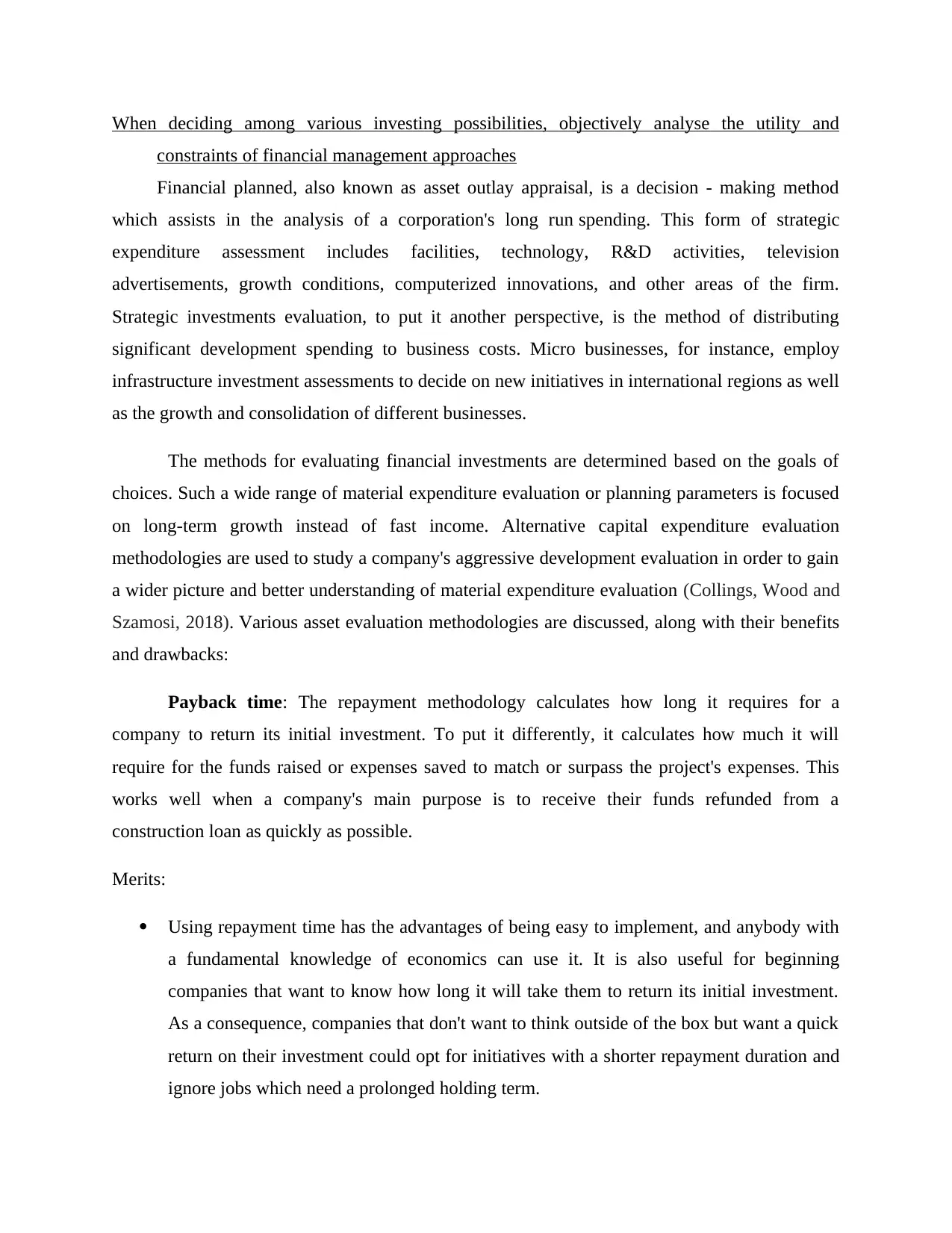
When deciding among various investing possibilities, objectively analyse the utility and
constraints of financial management approaches
Financial planned, also known as asset outlay appraisal, is a decision - making method
which assists in the analysis of a corporation's long run spending. This form of strategic
expenditure assessment includes facilities, technology, R&D activities, television
advertisements, growth conditions, computerized innovations, and other areas of the firm.
Strategic investments evaluation, to put it another perspective, is the method of distributing
significant development spending to business costs. Micro businesses, for instance, employ
infrastructure investment assessments to decide on new initiatives in international regions as well
as the growth and consolidation of different businesses.
The methods for evaluating financial investments are determined based on the goals of
choices. Such a wide range of material expenditure evaluation or planning parameters is focused
on long-term growth instead of fast income. Alternative capital expenditure evaluation
methodologies are used to study a company's aggressive development evaluation in order to gain
a wider picture and better understanding of material expenditure evaluation (Collings, Wood and
Szamosi, 2018). Various asset evaluation methodologies are discussed, along with their benefits
and drawbacks:
Payback time: The repayment methodology calculates how long it requires for a
company to return its initial investment. To put it differently, it calculates how much it will
require for the funds raised or expenses saved to match or surpass the project's expenses. This
works well when a company's main purpose is to receive their funds refunded from a
construction loan as quickly as possible.
Merits:
Using repayment time has the advantages of being easy to implement, and anybody with
a fundamental knowledge of economics can use it. It is also useful for beginning
companies that want to know how long it will take them to return its initial investment.
As a consequence, companies that don't want to think outside of the box but want a quick
return on their investment could opt for initiatives with a shorter repayment duration and
ignore jobs which need a prolonged holding term.
constraints of financial management approaches
Financial planned, also known as asset outlay appraisal, is a decision - making method
which assists in the analysis of a corporation's long run spending. This form of strategic
expenditure assessment includes facilities, technology, R&D activities, television
advertisements, growth conditions, computerized innovations, and other areas of the firm.
Strategic investments evaluation, to put it another perspective, is the method of distributing
significant development spending to business costs. Micro businesses, for instance, employ
infrastructure investment assessments to decide on new initiatives in international regions as well
as the growth and consolidation of different businesses.
The methods for evaluating financial investments are determined based on the goals of
choices. Such a wide range of material expenditure evaluation or planning parameters is focused
on long-term growth instead of fast income. Alternative capital expenditure evaluation
methodologies are used to study a company's aggressive development evaluation in order to gain
a wider picture and better understanding of material expenditure evaluation (Collings, Wood and
Szamosi, 2018). Various asset evaluation methodologies are discussed, along with their benefits
and drawbacks:
Payback time: The repayment methodology calculates how long it requires for a
company to return its initial investment. To put it differently, it calculates how much it will
require for the funds raised or expenses saved to match or surpass the project's expenses. This
works well when a company's main purpose is to receive their funds refunded from a
construction loan as quickly as possible.
Merits:
Using repayment time has the advantages of being easy to implement, and anybody with
a fundamental knowledge of economics can use it. It is also useful for beginning
companies that want to know how long it will take them to return its initial investment.
As a consequence, companies that don't want to think outside of the box but want a quick
return on their investment could opt for initiatives with a shorter repayment duration and
ignore jobs which need a prolonged holding term.
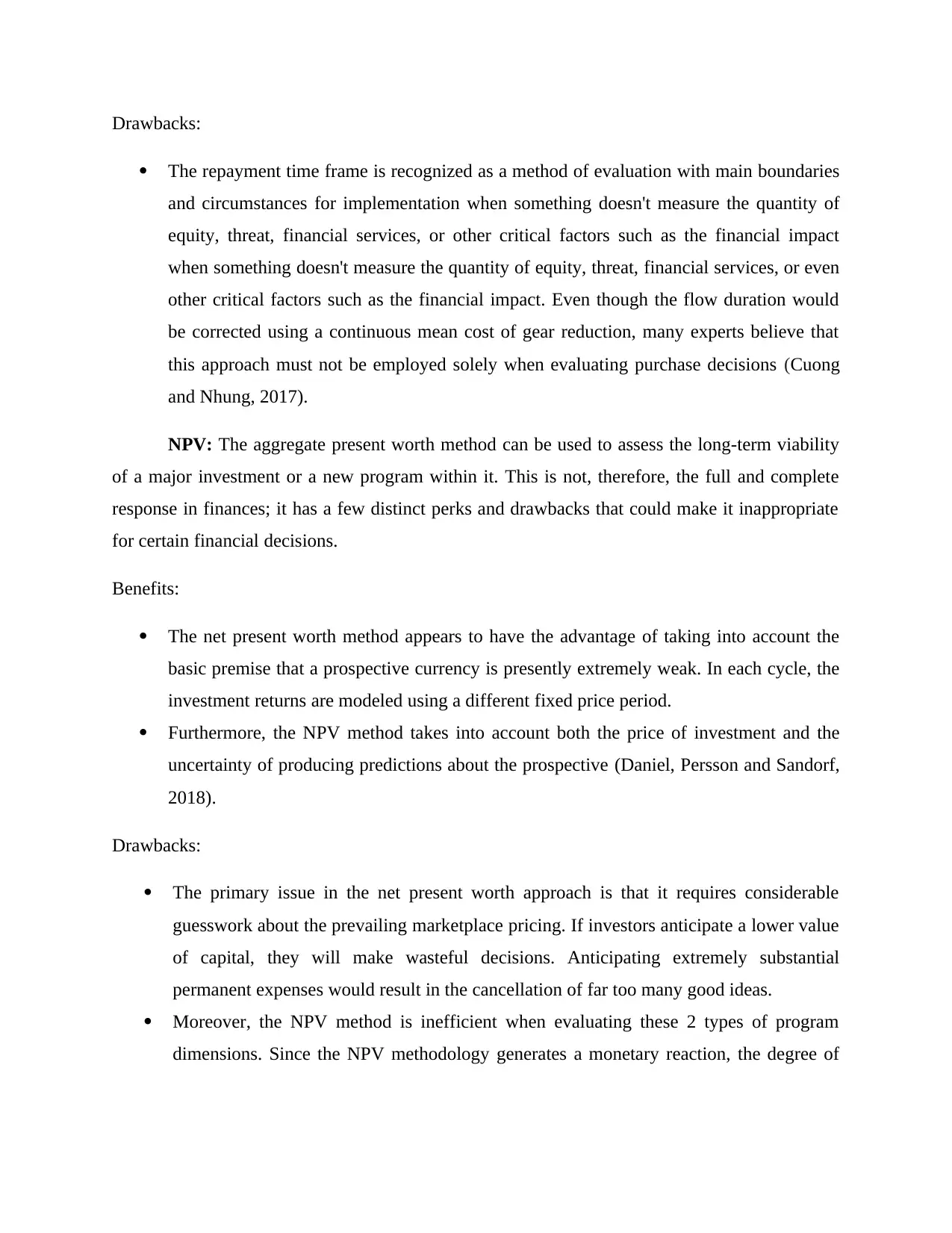
Drawbacks:
The repayment time frame is recognized as a method of evaluation with main boundaries
and circumstances for implementation when something doesn't measure the quantity of
equity, threat, financial services, or other critical factors such as the financial impact
when something doesn't measure the quantity of equity, threat, financial services, or even
other critical factors such as the financial impact. Even though the flow duration would
be corrected using a continuous mean cost of gear reduction, many experts believe that
this approach must not be employed solely when evaluating purchase decisions (Cuong
and Nhung, 2017).
NPV: The aggregate present worth method can be used to assess the long-term viability
of a major investment or a new program within it. This is not, therefore, the full and complete
response in finances; it has a few distinct perks and drawbacks that could make it inappropriate
for certain financial decisions.
Benefits:
The net present worth method appears to have the advantage of taking into account the
basic premise that a prospective currency is presently extremely weak. In each cycle, the
investment returns are modeled using a different fixed price period.
Furthermore, the NPV method takes into account both the price of investment and the
uncertainty of producing predictions about the prospective (Daniel, Persson and Sandorf,
2018).
Drawbacks:
The primary issue in the net present worth approach is that it requires considerable
guesswork about the prevailing marketplace pricing. If investors anticipate a lower value
of capital, they will make wasteful decisions. Anticipating extremely substantial
permanent expenses would result in the cancellation of far too many good ideas.
Moreover, the NPV method is inefficient when evaluating these 2 types of program
dimensions. Since the NPV methodology generates a monetary reaction, the degree of
The repayment time frame is recognized as a method of evaluation with main boundaries
and circumstances for implementation when something doesn't measure the quantity of
equity, threat, financial services, or other critical factors such as the financial impact
when something doesn't measure the quantity of equity, threat, financial services, or even
other critical factors such as the financial impact. Even though the flow duration would
be corrected using a continuous mean cost of gear reduction, many experts believe that
this approach must not be employed solely when evaluating purchase decisions (Cuong
and Nhung, 2017).
NPV: The aggregate present worth method can be used to assess the long-term viability
of a major investment or a new program within it. This is not, therefore, the full and complete
response in finances; it has a few distinct perks and drawbacks that could make it inappropriate
for certain financial decisions.
Benefits:
The net present worth method appears to have the advantage of taking into account the
basic premise that a prospective currency is presently extremely weak. In each cycle, the
investment returns are modeled using a different fixed price period.
Furthermore, the NPV method takes into account both the price of investment and the
uncertainty of producing predictions about the prospective (Daniel, Persson and Sandorf,
2018).
Drawbacks:
The primary issue in the net present worth approach is that it requires considerable
guesswork about the prevailing marketplace pricing. If investors anticipate a lower value
of capital, they will make wasteful decisions. Anticipating extremely substantial
permanent expenses would result in the cancellation of far too many good ideas.
Moreover, the NPV method is inefficient when evaluating these 2 types of program
dimensions. Since the NPV methodology generates a monetary reaction, the degree of
⊘ This is a preview!⊘
Do you want full access?
Subscribe today to unlock all pages.

Trusted by 1+ million students worldwide
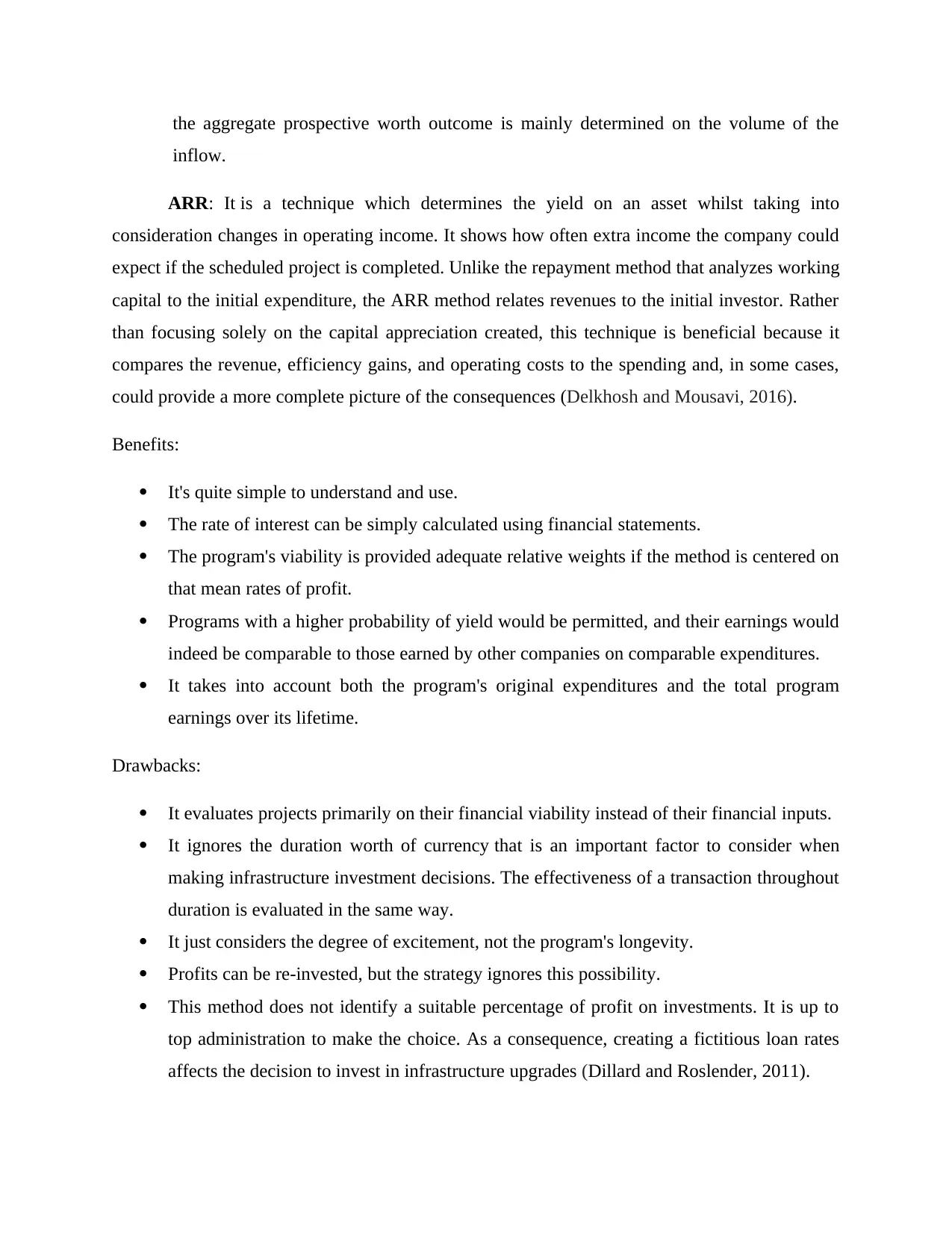
the aggregate prospective worth outcome is mainly determined on the volume of the
inflow.
ARR: It is a technique which determines the yield on an asset whilst taking into
consideration changes in operating income. It shows how often extra income the company could
expect if the scheduled project is completed. Unlike the repayment method that analyzes working
capital to the initial expenditure, the ARR method relates revenues to the initial investor. Rather
than focusing solely on the capital appreciation created, this technique is beneficial because it
compares the revenue, efficiency gains, and operating costs to the spending and, in some cases,
could provide a more complete picture of the consequences (Delkhosh and Mousavi, 2016).
Benefits:
It's quite simple to understand and use.
The rate of interest can be simply calculated using financial statements.
The program's viability is provided adequate relative weights if the method is centered on
that mean rates of profit.
Programs with a higher probability of yield would be permitted, and their earnings would
indeed be comparable to those earned by other companies on comparable expenditures.
It takes into account both the program's original expenditures and the total program
earnings over its lifetime.
Drawbacks:
It evaluates projects primarily on their financial viability instead of their financial inputs.
It ignores the duration worth of currency that is an important factor to consider when
making infrastructure investment decisions. The effectiveness of a transaction throughout
duration is evaluated in the same way.
It just considers the degree of excitement, not the program's longevity.
Profits can be re-invested, but the strategy ignores this possibility.
This method does not identify a suitable percentage of profit on investments. It is up to
top administration to make the choice. As a consequence, creating a fictitious loan rates
affects the decision to invest in infrastructure upgrades (Dillard and Roslender, 2011).
inflow.
ARR: It is a technique which determines the yield on an asset whilst taking into
consideration changes in operating income. It shows how often extra income the company could
expect if the scheduled project is completed. Unlike the repayment method that analyzes working
capital to the initial expenditure, the ARR method relates revenues to the initial investor. Rather
than focusing solely on the capital appreciation created, this technique is beneficial because it
compares the revenue, efficiency gains, and operating costs to the spending and, in some cases,
could provide a more complete picture of the consequences (Delkhosh and Mousavi, 2016).
Benefits:
It's quite simple to understand and use.
The rate of interest can be simply calculated using financial statements.
The program's viability is provided adequate relative weights if the method is centered on
that mean rates of profit.
Programs with a higher probability of yield would be permitted, and their earnings would
indeed be comparable to those earned by other companies on comparable expenditures.
It takes into account both the program's original expenditures and the total program
earnings over its lifetime.
Drawbacks:
It evaluates projects primarily on their financial viability instead of their financial inputs.
It ignores the duration worth of currency that is an important factor to consider when
making infrastructure investment decisions. The effectiveness of a transaction throughout
duration is evaluated in the same way.
It just considers the degree of excitement, not the program's longevity.
Profits can be re-invested, but the strategy ignores this possibility.
This method does not identify a suitable percentage of profit on investments. It is up to
top administration to make the choice. As a consequence, creating a fictitious loan rates
affects the decision to invest in infrastructure upgrades (Dillard and Roslender, 2011).
Paraphrase This Document
Need a fresh take? Get an instant paraphrase of this document with our AI Paraphraser
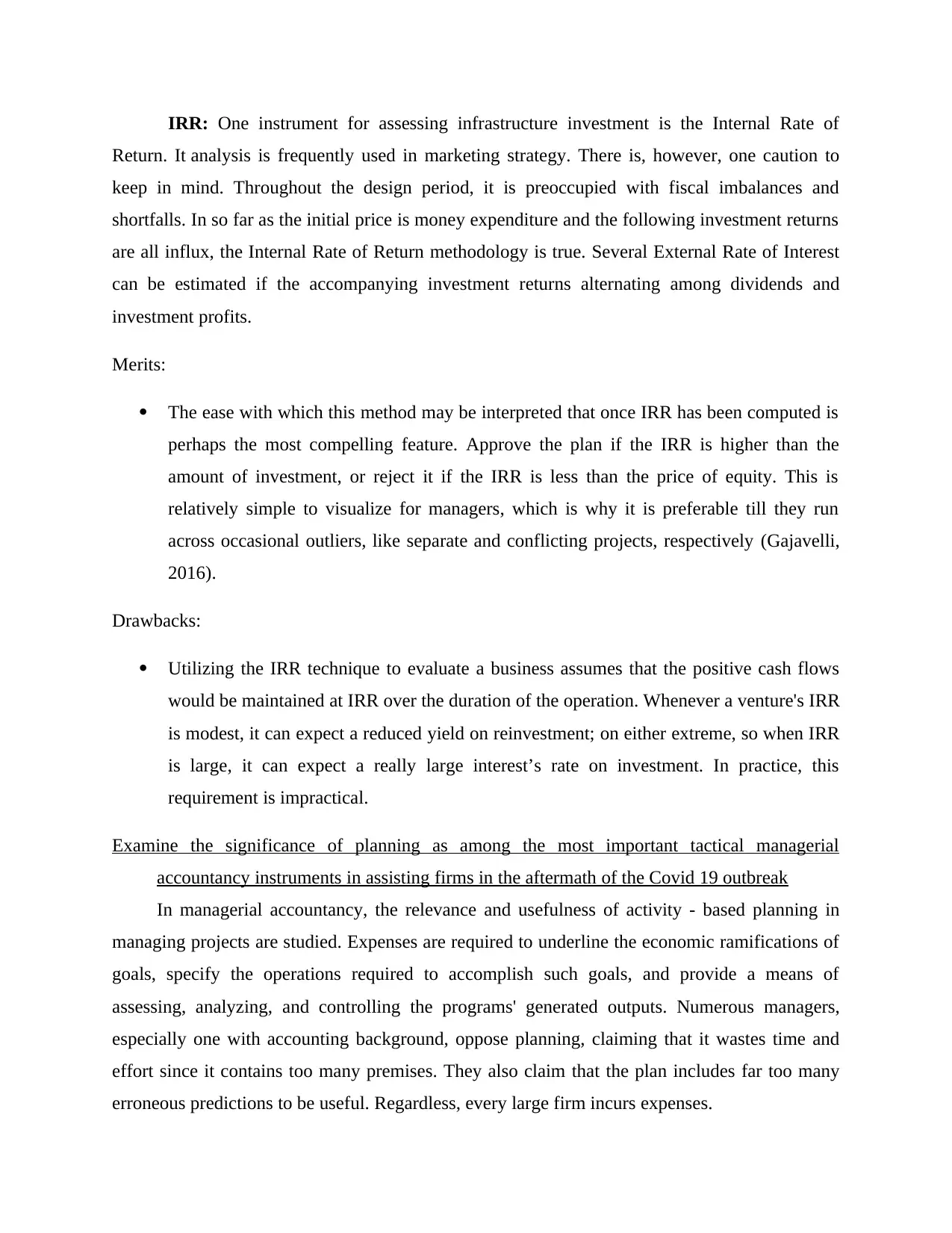
IRR: One instrument for assessing infrastructure investment is the Internal Rate of
Return. It analysis is frequently used in marketing strategy. There is, however, one caution to
keep in mind. Throughout the design period, it is preoccupied with fiscal imbalances and
shortfalls. In so far as the initial price is money expenditure and the following investment returns
are all influx, the Internal Rate of Return methodology is true. Several External Rate of Interest
can be estimated if the accompanying investment returns alternating among dividends and
investment profits.
Merits:
The ease with which this method may be interpreted that once IRR has been computed is
perhaps the most compelling feature. Approve the plan if the IRR is higher than the
amount of investment, or reject it if the IRR is less than the price of equity. This is
relatively simple to visualize for managers, which is why it is preferable till they run
across occasional outliers, like separate and conflicting projects, respectively (Gajavelli,
2016).
Drawbacks:
Utilizing the IRR technique to evaluate a business assumes that the positive cash flows
would be maintained at IRR over the duration of the operation. Whenever a venture's IRR
is modest, it can expect a reduced yield on reinvestment; on either extreme, so when IRR
is large, it can expect a really large interest’s rate on investment. In practice, this
requirement is impractical.
Examine the significance of planning as among the most important tactical managerial
accountancy instruments in assisting firms in the aftermath of the Covid 19 outbreak
In managerial accountancy, the relevance and usefulness of activity - based planning in
managing projects are studied. Expenses are required to underline the economic ramifications of
goals, specify the operations required to accomplish such goals, and provide a means of
assessing, analyzing, and controlling the programs' generated outputs. Numerous managers,
especially one with accounting background, oppose planning, claiming that it wastes time and
effort since it contains too many premises. They also claim that the plan includes far too many
erroneous predictions to be useful. Regardless, every large firm incurs expenses.
Return. It analysis is frequently used in marketing strategy. There is, however, one caution to
keep in mind. Throughout the design period, it is preoccupied with fiscal imbalances and
shortfalls. In so far as the initial price is money expenditure and the following investment returns
are all influx, the Internal Rate of Return methodology is true. Several External Rate of Interest
can be estimated if the accompanying investment returns alternating among dividends and
investment profits.
Merits:
The ease with which this method may be interpreted that once IRR has been computed is
perhaps the most compelling feature. Approve the plan if the IRR is higher than the
amount of investment, or reject it if the IRR is less than the price of equity. This is
relatively simple to visualize for managers, which is why it is preferable till they run
across occasional outliers, like separate and conflicting projects, respectively (Gajavelli,
2016).
Drawbacks:
Utilizing the IRR technique to evaluate a business assumes that the positive cash flows
would be maintained at IRR over the duration of the operation. Whenever a venture's IRR
is modest, it can expect a reduced yield on reinvestment; on either extreme, so when IRR
is large, it can expect a really large interest’s rate on investment. In practice, this
requirement is impractical.
Examine the significance of planning as among the most important tactical managerial
accountancy instruments in assisting firms in the aftermath of the Covid 19 outbreak
In managerial accountancy, the relevance and usefulness of activity - based planning in
managing projects are studied. Expenses are required to underline the economic ramifications of
goals, specify the operations required to accomplish such goals, and provide a means of
assessing, analyzing, and controlling the programs' generated outputs. Numerous managers,
especially one with accounting background, oppose planning, claiming that it wastes time and
effort since it contains too many premises. They also claim that the plan includes far too many
erroneous predictions to be useful. Regardless, every large firm incurs expenses.
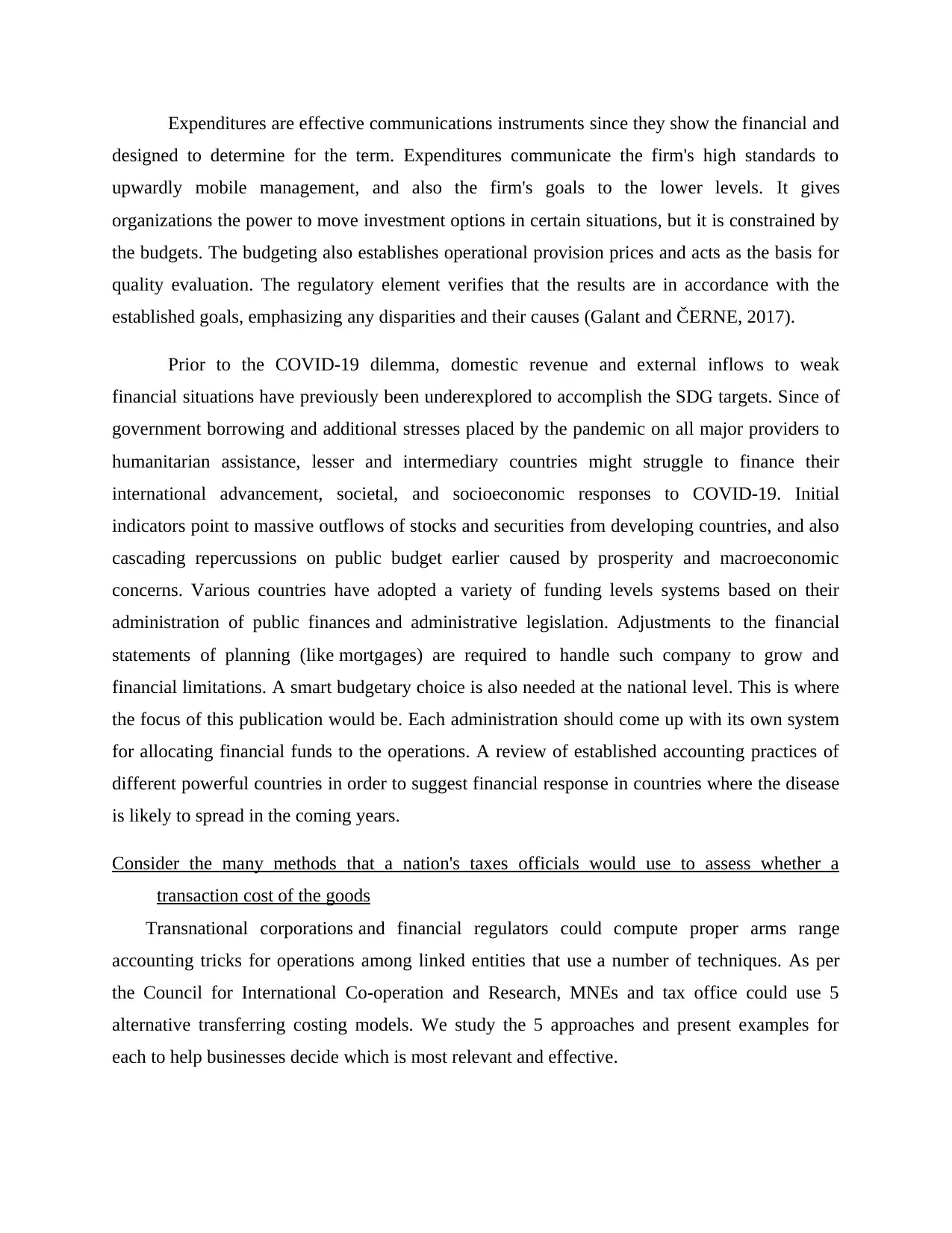
Expenditures are effective communications instruments since they show the financial and
designed to determine for the term. Expenditures communicate the firm's high standards to
upwardly mobile management, and also the firm's goals to the lower levels. It gives
organizations the power to move investment options in certain situations, but it is constrained by
the budgets. The budgeting also establishes operational provision prices and acts as the basis for
quality evaluation. The regulatory element verifies that the results are in accordance with the
established goals, emphasizing any disparities and their causes (Galant and ČERNE, 2017).
Prior to the COVID-19 dilemma, domestic revenue and external inflows to weak
financial situations have previously been underexplored to accomplish the SDG targets. Since of
government borrowing and additional stresses placed by the pandemic on all major providers to
humanitarian assistance, lesser and intermediary countries might struggle to finance their
international advancement, societal, and socioeconomic responses to COVID-19. Initial
indicators point to massive outflows of stocks and securities from developing countries, and also
cascading repercussions on public budget earlier caused by prosperity and macroeconomic
concerns. Various countries have adopted a variety of funding levels systems based on their
administration of public finances and administrative legislation. Adjustments to the financial
statements of planning (like mortgages) are required to handle such company to grow and
financial limitations. A smart budgetary choice is also needed at the national level. This is where
the focus of this publication would be. Each administration should come up with its own system
for allocating financial funds to the operations. A review of established accounting practices of
different powerful countries in order to suggest financial response in countries where the disease
is likely to spread in the coming years.
Consider the many methods that a nation's taxes officials would use to assess whether a
transaction cost of the goods
Transnational corporations and financial regulators could compute proper arms range
accounting tricks for operations among linked entities that use a number of techniques. As per
the Council for International Co-operation and Research, MNEs and tax office could use 5
alternative transferring costing models. We study the 5 approaches and present examples for
each to help businesses decide which is most relevant and effective.
designed to determine for the term. Expenditures communicate the firm's high standards to
upwardly mobile management, and also the firm's goals to the lower levels. It gives
organizations the power to move investment options in certain situations, but it is constrained by
the budgets. The budgeting also establishes operational provision prices and acts as the basis for
quality evaluation. The regulatory element verifies that the results are in accordance with the
established goals, emphasizing any disparities and their causes (Galant and ČERNE, 2017).
Prior to the COVID-19 dilemma, domestic revenue and external inflows to weak
financial situations have previously been underexplored to accomplish the SDG targets. Since of
government borrowing and additional stresses placed by the pandemic on all major providers to
humanitarian assistance, lesser and intermediary countries might struggle to finance their
international advancement, societal, and socioeconomic responses to COVID-19. Initial
indicators point to massive outflows of stocks and securities from developing countries, and also
cascading repercussions on public budget earlier caused by prosperity and macroeconomic
concerns. Various countries have adopted a variety of funding levels systems based on their
administration of public finances and administrative legislation. Adjustments to the financial
statements of planning (like mortgages) are required to handle such company to grow and
financial limitations. A smart budgetary choice is also needed at the national level. This is where
the focus of this publication would be. Each administration should come up with its own system
for allocating financial funds to the operations. A review of established accounting practices of
different powerful countries in order to suggest financial response in countries where the disease
is likely to spread in the coming years.
Consider the many methods that a nation's taxes officials would use to assess whether a
transaction cost of the goods
Transnational corporations and financial regulators could compute proper arms range
accounting tricks for operations among linked entities that use a number of techniques. As per
the Council for International Co-operation and Research, MNEs and tax office could use 5
alternative transferring costing models. We study the 5 approaches and present examples for
each to help businesses decide which is most relevant and effective.
⊘ This is a preview!⊘
Do you want full access?
Subscribe today to unlock all pages.

Trusted by 1+ million students worldwide
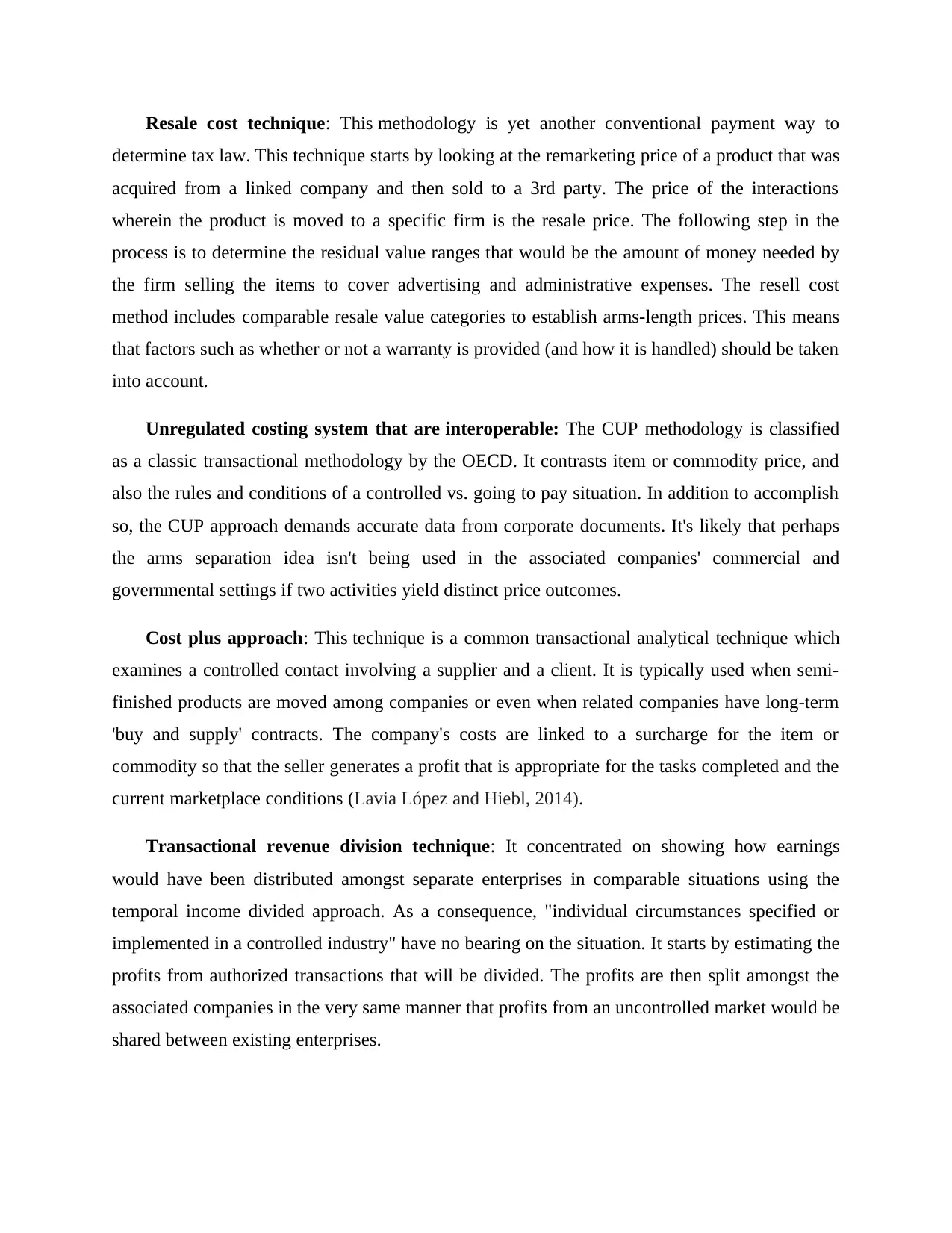
Resale cost technique: This methodology is yet another conventional payment way to
determine tax law. This technique starts by looking at the remarketing price of a product that was
acquired from a linked company and then sold to a 3rd party. The price of the interactions
wherein the product is moved to a specific firm is the resale price. The following step in the
process is to determine the residual value ranges that would be the amount of money needed by
the firm selling the items to cover advertising and administrative expenses. The resell cost
method includes comparable resale value categories to establish arms-length prices. This means
that factors such as whether or not a warranty is provided (and how it is handled) should be taken
into account.
Unregulated costing system that are interoperable: The CUP methodology is classified
as a classic transactional methodology by the OECD. It contrasts item or commodity price, and
also the rules and conditions of a controlled vs. going to pay situation. In addition to accomplish
so, the CUP approach demands accurate data from corporate documents. It's likely that perhaps
the arms separation idea isn't being used in the associated companies' commercial and
governmental settings if two activities yield distinct price outcomes.
Cost plus approach: This technique is a common transactional analytical technique which
examines a controlled contact involving a supplier and a client. It is typically used when semi-
finished products are moved among companies or even when related companies have long-term
'buy and supply' contracts. The company's costs are linked to a surcharge for the item or
commodity so that the seller generates a profit that is appropriate for the tasks completed and the
current marketplace conditions (Lavia López and Hiebl, 2014).
Transactional revenue division technique: It concentrated on showing how earnings
would have been distributed amongst separate enterprises in comparable situations using the
temporal income divided approach. As a consequence, "individual circumstances specified or
implemented in a controlled industry" have no bearing on the situation. It starts by estimating the
profits from authorized transactions that will be divided. The profits are then split amongst the
associated companies in the very same manner that profits from an uncontrolled market would be
shared between existing enterprises.
determine tax law. This technique starts by looking at the remarketing price of a product that was
acquired from a linked company and then sold to a 3rd party. The price of the interactions
wherein the product is moved to a specific firm is the resale price. The following step in the
process is to determine the residual value ranges that would be the amount of money needed by
the firm selling the items to cover advertising and administrative expenses. The resell cost
method includes comparable resale value categories to establish arms-length prices. This means
that factors such as whether or not a warranty is provided (and how it is handled) should be taken
into account.
Unregulated costing system that are interoperable: The CUP methodology is classified
as a classic transactional methodology by the OECD. It contrasts item or commodity price, and
also the rules and conditions of a controlled vs. going to pay situation. In addition to accomplish
so, the CUP approach demands accurate data from corporate documents. It's likely that perhaps
the arms separation idea isn't being used in the associated companies' commercial and
governmental settings if two activities yield distinct price outcomes.
Cost plus approach: This technique is a common transactional analytical technique which
examines a controlled contact involving a supplier and a client. It is typically used when semi-
finished products are moved among companies or even when related companies have long-term
'buy and supply' contracts. The company's costs are linked to a surcharge for the item or
commodity so that the seller generates a profit that is appropriate for the tasks completed and the
current marketplace conditions (Lavia López and Hiebl, 2014).
Transactional revenue division technique: It concentrated on showing how earnings
would have been distributed amongst separate enterprises in comparable situations using the
temporal income divided approach. As a consequence, "individual circumstances specified or
implemented in a controlled industry" have no bearing on the situation. It starts by estimating the
profits from authorized transactions that will be divided. The profits are then split amongst the
associated companies in the very same manner that profits from an uncontrolled market would be
shared between existing enterprises.
Paraphrase This Document
Need a fresh take? Get an instant paraphrase of this document with our AI Paraphraser
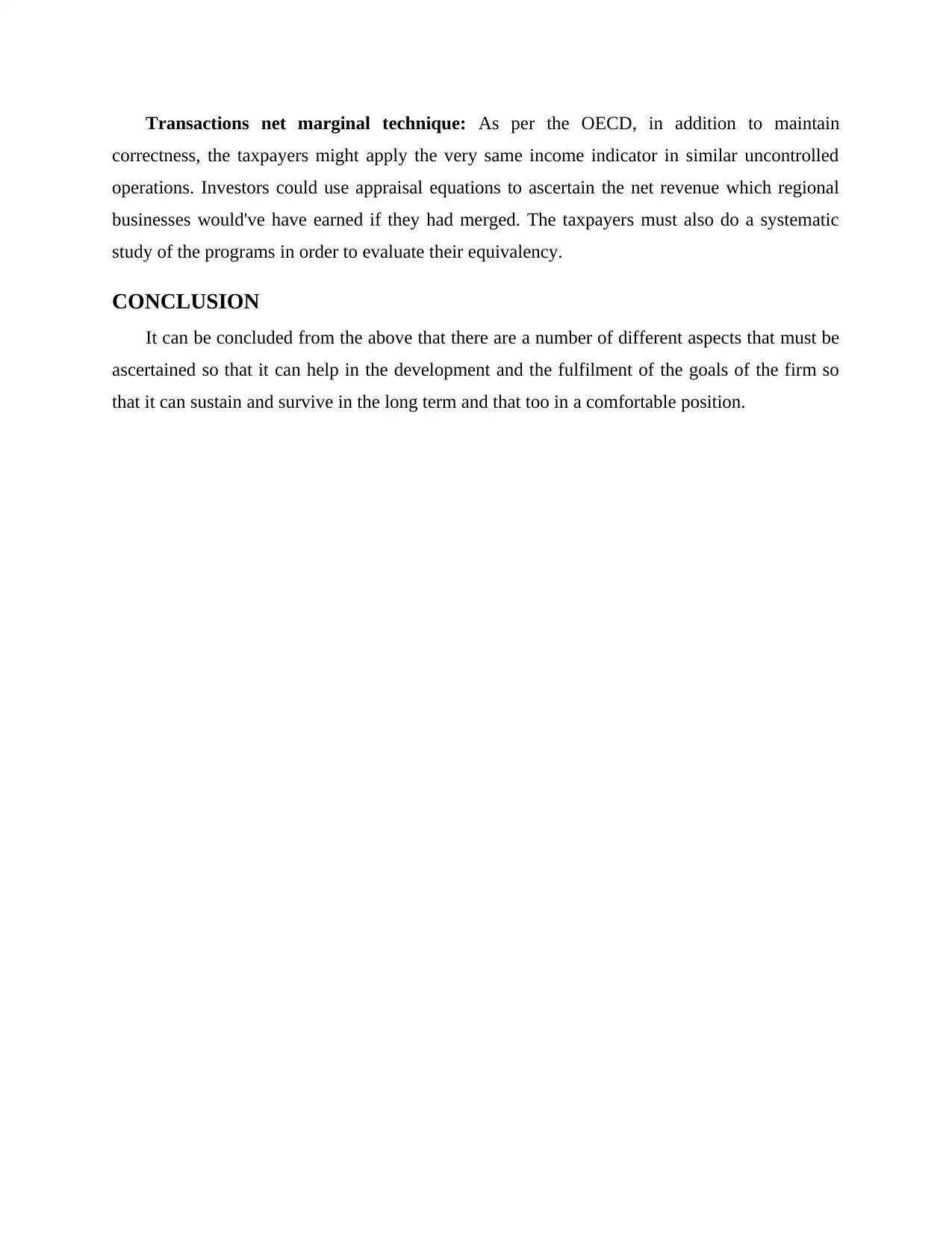
Transactions net marginal technique: As per the OECD, in addition to maintain
correctness, the taxpayers might apply the very same income indicator in similar uncontrolled
operations. Investors could use appraisal equations to ascertain the net revenue which regional
businesses would've have earned if they had merged. The taxpayers must also do a systematic
study of the programs in order to evaluate their equivalency.
CONCLUSION
It can be concluded from the above that there are a number of different aspects that must be
ascertained so that it can help in the development and the fulfilment of the goals of the firm so
that it can sustain and survive in the long term and that too in a comfortable position.
correctness, the taxpayers might apply the very same income indicator in similar uncontrolled
operations. Investors could use appraisal equations to ascertain the net revenue which regional
businesses would've have earned if they had merged. The taxpayers must also do a systematic
study of the programs in order to evaluate their equivalency.
CONCLUSION
It can be concluded from the above that there are a number of different aspects that must be
ascertained so that it can help in the development and the fulfilment of the goals of the firm so
that it can sustain and survive in the long term and that too in a comfortable position.
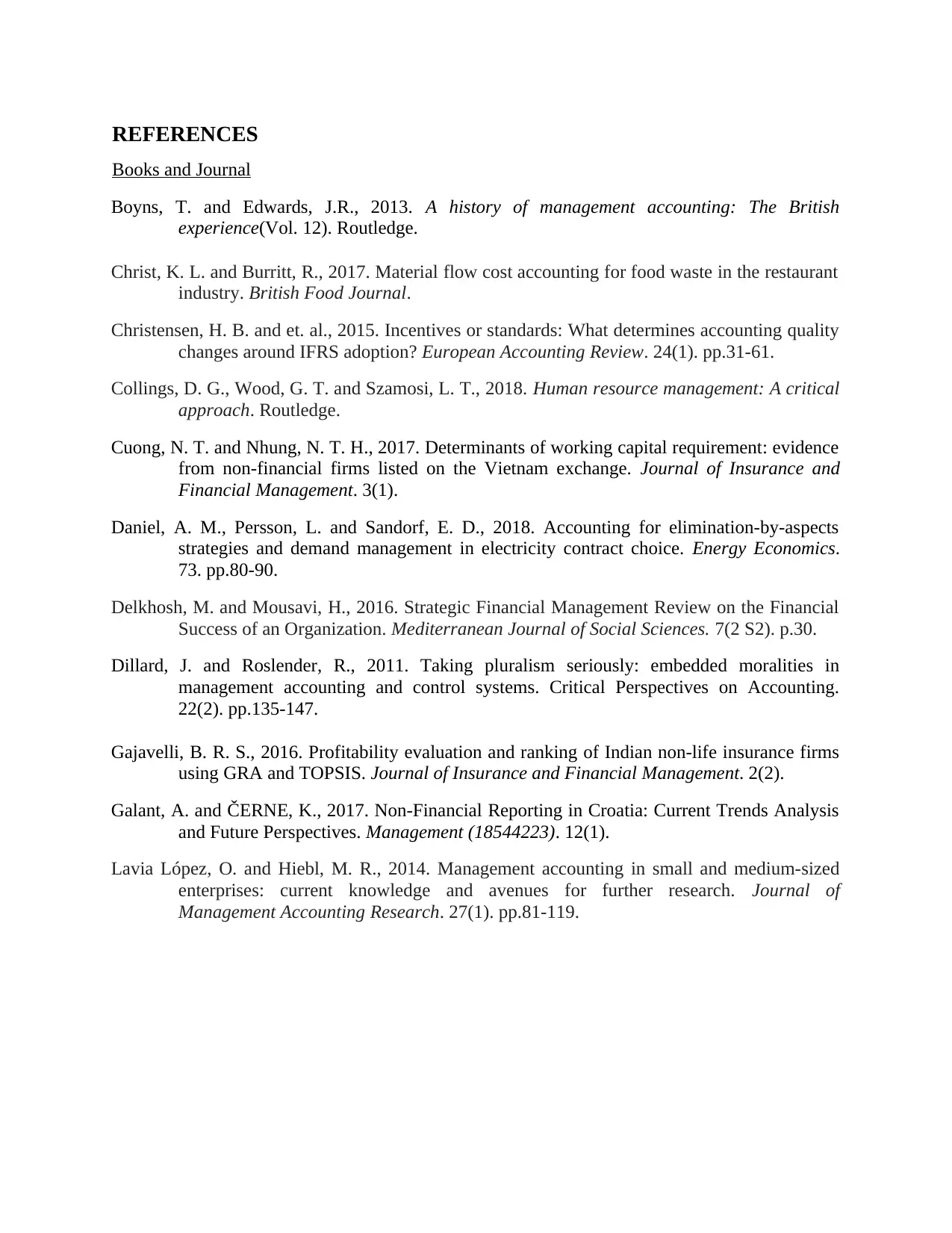
REFERENCES
Books and Journal
Boyns, T. and Edwards, J.R., 2013. A history of management accounting: The British
experience(Vol. 12). Routledge.
Christ, K. L. and Burritt, R., 2017. Material flow cost accounting for food waste in the restaurant
industry. British Food Journal.
Christensen, H. B. and et. al., 2015. Incentives or standards: What determines accounting quality
changes around IFRS adoption? European Accounting Review. 24(1). pp.31-61.
Collings, D. G., Wood, G. T. and Szamosi, L. T., 2018. Human resource management: A critical
approach. Routledge.
Cuong, N. T. and Nhung, N. T. H., 2017. Determinants of working capital requirement: evidence
from non-financial firms listed on the Vietnam exchange. Journal of Insurance and
Financial Management. 3(1).
Daniel, A. M., Persson, L. and Sandorf, E. D., 2018. Accounting for elimination-by-aspects
strategies and demand management in electricity contract choice. Energy Economics.
73. pp.80-90.
Delkhosh, M. and Mousavi, H., 2016. Strategic Financial Management Review on the Financial
Success of an Organization. Mediterranean Journal of Social Sciences. 7(2 S2). p.30.
Dillard, J. and Roslender, R., 2011. Taking pluralism seriously: embedded moralities in
management accounting and control systems. Critical Perspectives on Accounting.
22(2). pp.135-147.
Gajavelli, B. R. S., 2016. Profitability evaluation and ranking of Indian non-life insurance firms
using GRA and TOPSIS. Journal of Insurance and Financial Management. 2(2).
Galant, A. and ČERNE, K., 2017. Non-Financial Reporting in Croatia: Current Trends Analysis
and Future Perspectives. Management (18544223). 12(1).
Lavia López, O. and Hiebl, M. R., 2014. Management accounting in small and medium-sized
enterprises: current knowledge and avenues for further research. Journal of
Management Accounting Research. 27(1). pp.81-119.
Books and Journal
Boyns, T. and Edwards, J.R., 2013. A history of management accounting: The British
experience(Vol. 12). Routledge.
Christ, K. L. and Burritt, R., 2017. Material flow cost accounting for food waste in the restaurant
industry. British Food Journal.
Christensen, H. B. and et. al., 2015. Incentives or standards: What determines accounting quality
changes around IFRS adoption? European Accounting Review. 24(1). pp.31-61.
Collings, D. G., Wood, G. T. and Szamosi, L. T., 2018. Human resource management: A critical
approach. Routledge.
Cuong, N. T. and Nhung, N. T. H., 2017. Determinants of working capital requirement: evidence
from non-financial firms listed on the Vietnam exchange. Journal of Insurance and
Financial Management. 3(1).
Daniel, A. M., Persson, L. and Sandorf, E. D., 2018. Accounting for elimination-by-aspects
strategies and demand management in electricity contract choice. Energy Economics.
73. pp.80-90.
Delkhosh, M. and Mousavi, H., 2016. Strategic Financial Management Review on the Financial
Success of an Organization. Mediterranean Journal of Social Sciences. 7(2 S2). p.30.
Dillard, J. and Roslender, R., 2011. Taking pluralism seriously: embedded moralities in
management accounting and control systems. Critical Perspectives on Accounting.
22(2). pp.135-147.
Gajavelli, B. R. S., 2016. Profitability evaluation and ranking of Indian non-life insurance firms
using GRA and TOPSIS. Journal of Insurance and Financial Management. 2(2).
Galant, A. and ČERNE, K., 2017. Non-Financial Reporting in Croatia: Current Trends Analysis
and Future Perspectives. Management (18544223). 12(1).
Lavia López, O. and Hiebl, M. R., 2014. Management accounting in small and medium-sized
enterprises: current knowledge and avenues for further research. Journal of
Management Accounting Research. 27(1). pp.81-119.
⊘ This is a preview!⊘
Do you want full access?
Subscribe today to unlock all pages.

Trusted by 1+ million students worldwide
1 out of 12
Related Documents
Your All-in-One AI-Powered Toolkit for Academic Success.
+13062052269
info@desklib.com
Available 24*7 on WhatsApp / Email
![[object Object]](/_next/static/media/star-bottom.7253800d.svg)
Unlock your academic potential
Copyright © 2020–2025 A2Z Services. All Rights Reserved. Developed and managed by ZUCOL.


